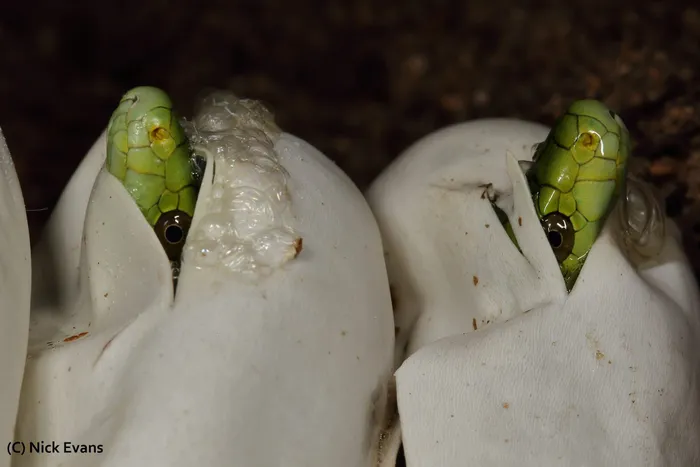PICS: Eggs from green mamba rescued in eManzimtoti hatch

It took just under 3 months for them to hatch, being incubated in a warm room. The nine hatchling mambas measured out at 44–48cm in length. Picture: Nick Evans
Durban snake rescuer Nick Evans said hatching season is well under way for most snake species and that is “an exciting time for snake enthusiasts!”
Earlier in the summer, Evans rescued several gravid (pregnant) snakes. They were given a safe space to lay their eggs and then released.
He said that in the wild, female snakes would lay their eggs and leave them, with the southern African python being the exception – “they’re excellent mothers” – Evans said.
“So I ended up with loads of eggs from a variety of species. It provides me with a special opportunity to collect a lot of data on snake reproduction, which I’ve been working hard on. Plus, it’s really interesting and a privilege to watch snakes hatch,” Evans said.

He shared photographs of green mambas hatching.
“I caught their heavily gravid mother under corrugated iron, a few months ago, in eManzimtoti,” Evans said. “It took just under three months for them to hatch, being incubated in a warm room.”
“The nine hatchling mambas measured out at 44–48cm in length. Fairly big babies. Black mamba hatchlings are about 10cm longer or more,” Evans said.
“Yes, venomous species such as these have their venom from day one. Not to kill people, but to catch their prey.”
Evans said all hatchlings have been released in a natural area away from humans. Some may survive to adulthood, but many will get picked off by predators. That is nature. Snakes are a part of the food chain.

“I can’t raise these babies till they’re adults and then release them. That could start causing an imbalance in the population/ecosystem,” Evans explained.
“Practically, that would require space I don’t have and money to feed them.
“Also, they could pick up parasites in captivity that could potentially be harmful to wild snakes,” Evans continued.
“As snake removers, we do interfere with nature, it’s our job, and it’s necessary. But we try to limit that interference to as little as possible.”

In November last year, Evans shared that a pregnant green mamba laid nine healthy eggs three days after she was rescued in eManzimtoti.
Evans had gone to a home in the eManzimtoti area for a green mamba hiding under sheets of asbestos and corrugated iron.

At the time he said that November is the time of year when green mambas are seen more on the ground than usual, mostly because they are gravid. They come down looking for a spot to lay their eggs.
Evans said green mambas generally occur on the KwaZulu-Natal coastline. They stick to trees and are quite elusive.
During the rescue, Evans looked under the pile of roof sheeting and saw the mamba under all of it, on the ground. He moved sheet after sheet, going as carefully as possible, to avoid hurting her. When he was down to the last piece of asbestos, he flipped it, exposing the snake, and her hideout. He could tell straight away she was gravid by her swollen back half.
He said it looked like a decent place to lay. He also said it was a quick and easy catch, apart from the roof sheeting in his way.
“I could see she was about to pop, so I put her in an enclosure with a box to hide in and lay.
“Three days later, she laid nine healthy eggs,” Evans said at the time.

On Monday, just before 8am, Evans was sent a video of a small, dark snake on top of a shrub at a business premises in Westville and he could tell it was a hatchling black mamba.
He said now is the time of year black mambas, and most species of snakes, are hatching. It does not mean Durban is about to be swarmed with young, bloodthirsty snakes. Another important fact to remember is the mother snake is not nearby, watching her babies. That is often the first fear that comes to mind when people encounter a juvenile snake – “Where's the mother?!”
He said that male snakes move off after mating and female snakes lay their eggs and leave them.

Evans explained that when the baby snakes hatch, they disperse, they don’t stick together for safety in numbers. As they disperse, they get picked off by predators, such as birds, monitor lizards, genets and mongooses.
“So no, hatching season doesn’t mean that it needs to be panic season,” Evans said.
“Oh, also, please don’t ask a snake remover to come and find the nest, as there’s no nest to find, and the eggs are often laid underground.
“Black mambas hatch out at lengths of 50–60cm in length… Big babies. And yes, they are venomous from day one,” Evans said.
WhatsApp your views on this story at 071 485 7995.
Daily News